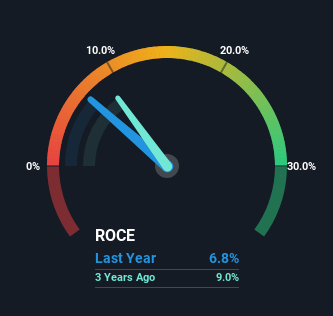- Hong Kong
- /
- Specialty Stores
- /
- SEHK:1872
Returns On Capital Signal Tricky Times Ahead For Guan Chao Holdings (HKG:1872)
Did you know there are some financial metrics that can provide clues of a potential multi-bagger? Firstly, we'll want to see a proven return on capital employed (ROCE) that is increasing, and secondly, an expanding base of capital employed. This shows us that it's a compounding machine, able to continually reinvest its earnings back into the business and generate higher returns. Although, when we looked at Guan Chao Holdings (HKG:1872), it didn't seem to tick all of these boxes.
What Is Return On Capital Employed (ROCE)?
Just to clarify if you're unsure, ROCE is a metric for evaluating how much pre-tax income (in percentage terms) a company earns on the capital invested in its business. Analysts use this formula to calculate it for Guan Chao Holdings:
Return on Capital Employed = Earnings Before Interest and Tax (EBIT) ÷ (Total Assets - Current Liabilities)
0.068 = S$6.6m ÷ (S$157m - S$60m) (Based on the trailing twelve months to December 2022).
Thus, Guan Chao Holdings has an ROCE of 6.8%. In absolute terms, that's a low return and it also under-performs the Specialty Retail industry average of 9.0%.
View our latest analysis for Guan Chao Holdings

Historical performance is a great place to start when researching a stock so above you can see the gauge for Guan Chao Holdings' ROCE against it's prior returns. If you want to delve into the historical earnings, revenue and cash flow of Guan Chao Holdings, check out these free graphs here.
What Can We Tell From Guan Chao Holdings' ROCE Trend?
On the surface, the trend of ROCE at Guan Chao Holdings doesn't inspire confidence. Around five years ago the returns on capital were 27%, but since then they've fallen to 6.8%. Given the business is employing more capital while revenue has slipped, this is a bit concerning. This could mean that the business is losing its competitive advantage or market share, because while more money is being put into ventures, it's actually producing a lower return - "less bang for their buck" per se.
On a related note, Guan Chao Holdings has decreased its current liabilities to 38% of total assets. That could partly explain why the ROCE has dropped. Effectively this means their suppliers or short-term creditors are funding less of the business, which reduces some elements of risk. Some would claim this reduces the business' efficiency at generating ROCE since it is now funding more of the operations with its own money.
The Key Takeaway
From the above analysis, we find it rather worrisome that returns on capital and sales for Guan Chao Holdings have fallen, meanwhile the business is employing more capital than it was five years ago. Long term shareholders who've owned the stock over the last three years have experienced a 40% depreciation in their investment, so it appears the market might not like these trends either. Unless there is a shift to a more positive trajectory in these metrics, we would look elsewhere.
On a final note, we found 4 warning signs for Guan Chao Holdings (3 are a bit unpleasant) you should be aware of.
For those who like to invest in solid companies, check out this free list of companies with solid balance sheets and high returns on equity.
New: Manage All Your Stock Portfolios in One Place
We've created the ultimate portfolio companion for stock investors, and it's free.
• Connect an unlimited number of Portfolios and see your total in one currency
• Be alerted to new Warning Signs or Risks via email or mobile
• Track the Fair Value of your stocks
Have feedback on this article? Concerned about the content? Get in touch with us directly. Alternatively, email editorial-team (at) simplywallst.com.
This article by Simply Wall St is general in nature. We provide commentary based on historical data and analyst forecasts only using an unbiased methodology and our articles are not intended to be financial advice. It does not constitute a recommendation to buy or sell any stock, and does not take account of your objectives, or your financial situation. We aim to bring you long-term focused analysis driven by fundamental data. Note that our analysis may not factor in the latest price-sensitive company announcements or qualitative material. Simply Wall St has no position in any stocks mentioned.
About SEHK:1872
Guan Chao Holdings
An investment holding company, engages in the sale of parallel-import and pre-owned motor vehicles in Singapore.
Adequate balance sheet with low risk.
Market Insights
Community Narratives


Recently Updated Narratives


No miracle in sight


Q3 Outlook modestly optimistic


Alphabet: The Under-appreciated Compounder Hiding in Plain Sight
Popular Narratives


The company that turned a verb into a global necessity and basically runs the modern internet, digital ads, smartphones, maps, and AI.


MicroVision will explode future revenue by 380.37% with a vision towards success



